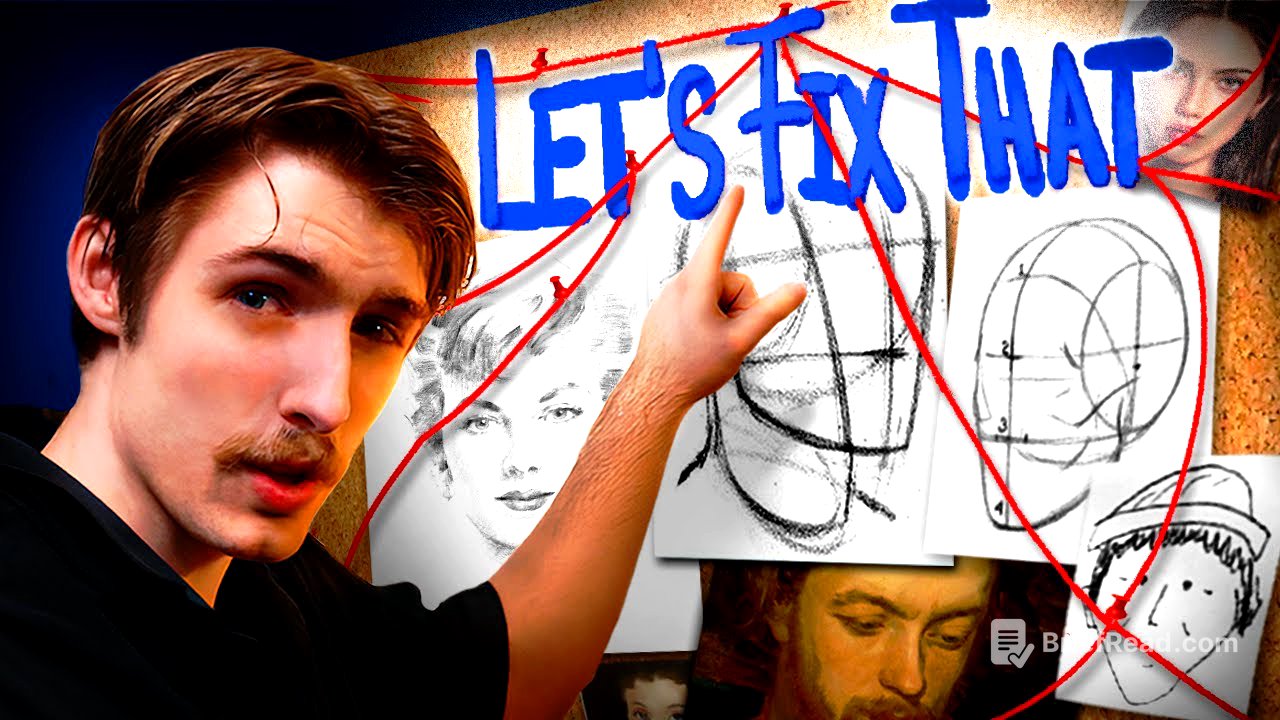TLDR;
This video explores the challenges of learning to draw portraits, particularly the head, and the journey to finding effective methods. It critiques common approaches like relying on tutorials without understanding underlying principles and emphasizes the importance of construction, understanding form, and continuous learning. The video also touches on historical art education methods and the balance between technical skill and artistic expression.
- Drawing portraits is difficult because it requires understanding physical qualities rather than just recognizing features.
- The Loomis method is a popular but often misunderstood approach to head drawing.
- Constructive drawing, focusing on form and understanding the skull, is essential.
- Historical art education emphasizes fundamental skills and individual creativity.
- The key to improvement is balancing learning, practice, and enjoying the process.
I suck at drawing [0:00]
The author reflects on the difficulty of drawing, especially portraits, noting that most people don't study drawing despite having drawn as children. He points out that describing someone's features (e.g., brown hair, blue eyes) doesn't provide the necessary information for drawing their likeness. The normal way we interact with the world is different from how an artist needs to perceive it. The author expresses feeling inadequate in his drawing skills and aims to improve by understanding where he's making mistakes, using a painting as an example where he straightened out a difficult pose from the reference photo, a common beginner tendency.
Drawing Portraits for Beginners [2:07]
The author suggests starting as if brand new to drawing, despite the frustration it may cause. He critiques typical beginner tutorials that focus on rulers, compasses, and precise measurements, finding them boring and akin to geometry rather than art. He also criticizes tutorials that focus on hyper-detailed rendering of features like the eye, calling the learning process a "hellish experience" due to the overwhelming and contradictory advice available online. Learning to draw is presented not as a skill curve, but as a steep cliff to climb.
The Loomis Method [4:14]
The video addresses the popular Loomis method for drawing heads, noting its prevalence in online tutorials, which often abstract the method from its original source. Instead of relying on these tutorials, the author advocates reading Andrew Loomis's book directly. The Loomis method involves starting with a ball, cutting off the sides, and using divisions to map out facial features. While the method provides essential drawing knowledge, it has limitations when the head rotates upwards or to the sides. The book contains a lot of great advice, but the author feels that the paragraph or two on each topic just doesn't feel like it's enough.
Ascent to Construction [8:19]
The author emphasizes the importance of construction in drawing, contrasting it with methods that rely solely on tools for accuracy, such as grids or tracing. He quotes Lumis, who says that mere duplication has little point and that drawing should be a means of expression, surpassing photography through imagination and individuality. The author suggests understanding the skull as a way to unravel the mystery of head drawing, referencing drawings from the Repin Academy as examples of form-based drawing. He aims to copy constructive diagramming from the school to solidify his understanding of the skull and how it breaks down into simple masses.
Into Madness [12:06]
The author describes his deep dive into Russian art education, seeking to bridge the gap left by Loomis. He references Savelyev's "Complete Drawing Course," a 19th-century Russian textbook, hoping it will provide the missing link. However, he finds the book confusing, with limited information on head rotations and an emphasis on basic perspective diagrams. He then turns to another book, "Drawing the Human Head" from the Soviet era, which advises breaking down drawing into smaller tasks and practicing individual parts before combining them.
Mania [16:13]
The author continues exploring the Soviet-era drawing book, which emphasizes tackling problems from general to specific, starting with the major masses of the head, like the skull. The book stresses the importance of understanding the shapes of the head rather than passively copying nature. It also provides step-by-step diagrams showing how to approach drawings. The author tests his knowledge by drawing a cast of Hercules, meticulously constructing it using a sphere shape and suggesting planes of the face. He expresses relief at finding answers and validating his approach through consistent work and research.
Loomis' Dark Secret [20:03]
The author draws a cast head of Venus, a more delicate form that tests his skills. He emphasizes the importance of making every line count, showing both form and light. He sets a challenge for his Discord community to draw from 19th-century photo references, aiming for technical perfection and subtle values. However, he encounters difficulties, feeling like he's slipping back into old habits and struggling with hatching and value integration.
Re-evaluation [22:15]
The author reflects on his struggles and revisits Loomis's book, finding a passage where Loomis humbly acknowledges his own limitations and emphasizes the importance of reverence for the beauty of the head's construction and constant experimentation. The author realizes that Loomis never intended for his method to be a rigid formula. He contrasts Loomis's approach with that of 19th-century art educators, who deliberately subdued their style to avoid influencing students too much. These educators focused on providing fundamental skills and encouraging students to figure things out on their own. The author concludes by emphasizing the importance of thinking from general to specific, understanding form, and enjoying the process of drawing.









